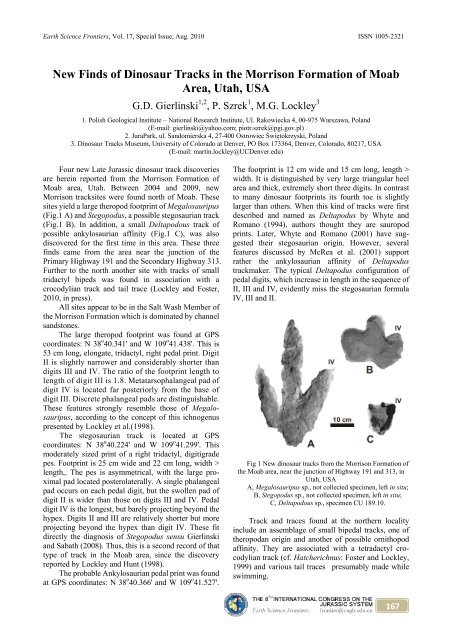in Jurassic and Cretaceous Stratigraphy
in Jurassic and Cretaceous Stratigraphy
in Jurassic and Cretaceous Stratigraphy
You also want an ePaper? Increase the reach of your titles
YUMPU automatically turns print PDFs into web optimized ePapers that Google loves.
Earth Science Frontiers, Vol. 17, Special Issue, Aug. 2010 ISSN 1005-2321<br />
New F<strong>in</strong>ds of D<strong>in</strong>osaur Tracks <strong>in</strong> the Morrison Formation of Moab<br />
Area, Utah, USA<br />
G.D. Gierl<strong>in</strong>ski 1,2 , P. Szrek 1 , M.G. Lockley 3<br />
1. Polish Geological Institute – National Research Institute, Ul. Rakowiecka 4, 00-975 Warszawa, Pol<strong>and</strong><br />
(E-mail: gierl<strong>in</strong>ski@yahoo.com; piotr.szrek@pgi.gov.pl)<br />
2. JuraPark, ul. S<strong>and</strong>omierska 4, 27-400 Ostrowiec Świętokrzyski, Pol<strong>and</strong><br />
3. D<strong>in</strong>osaur Tracks Museum, University of Colorado at Denver, PO Box 173364, Denver, Colorado, 80217, USA<br />
(E-mail: mart<strong>in</strong>.lockley@UCDenver.edu)<br />
Four new Late <strong>Jurassic</strong> d<strong>in</strong>osaur track discoveries<br />
are here<strong>in</strong> reported from the Morrison Formation of<br />
Moab area, Utah. Between 2004 <strong>and</strong> 2009, new<br />
Morrison tracksites were found north of Moab. These<br />
sites yield a large theropod footpr<strong>in</strong>t of Megalosauripus<br />
(Fig.1 A) <strong>and</strong> Stegopodus, a possible stegosaurian track<br />
(Fig.1 B). In addition, a small Deltapodous track of<br />
possible ankylosaurian aff<strong>in</strong>ity (Fig.1 C), was also<br />
discovered for the first time <strong>in</strong> this area. These three<br />
f<strong>in</strong>ds came from the area near the junction of the<br />
Primary Highway 191 <strong>and</strong> the Secondary Highway 313.<br />
Further to the north another site with tracks of small<br />
tridactyl bipeds was found <strong>in</strong> association with a<br />
crocodylian track <strong>and</strong> tail trace (Lockley <strong>and</strong> Foster,<br />
2010, <strong>in</strong> press).<br />
All sites appear to be <strong>in</strong> the Salt Wash Member of<br />
the Morrison Formation which is dom<strong>in</strong>ated by channel<br />
s<strong>and</strong>stones.<br />
The large theropod footpr<strong>in</strong>t was found at GPS<br />
coord<strong>in</strong>ates: N 38 o 40.341' <strong>and</strong> W 109 o 41.438'. This is<br />
53 cm long, elongate, tridactyl, right pedal pr<strong>in</strong>t. Digit<br />
II is slightly narrower <strong>and</strong> considerably shorter than<br />
digits III <strong>and</strong> IV. The ratio of the footpr<strong>in</strong>t length to<br />
length of digit III is 1.8. Metatarsophalangeal pad of<br />
digit IV is located far posteriorly from the base of<br />
digit III. Discrete phalangeal pads are dist<strong>in</strong>guishable.<br />
These features strongly resemble those of Megalo-<br />
sauripus, accord<strong>in</strong>g to the concept of this ichnogenus<br />
presented by Lockley et al.(1998).<br />
The stegosaurian track is located at GPS<br />
coord<strong>in</strong>ates: N 38 o 40.224' <strong>and</strong> W 109 o 41.299'. This<br />
moderately sized pr<strong>in</strong>t of a right tridactyl, digitigrade<br />
pes. Footpr<strong>in</strong>t is 25 cm wide <strong>and</strong> 22 cm long, width ><br />
length,. The pes is asymmetrical, with the large pro-<br />
ximal pad located posterolaterally. A s<strong>in</strong>gle phalangeal<br />
pad occurs on each pedal digit, but the swollen pad of<br />
digit II is wider than those on digits III <strong>and</strong> IV. Pedal<br />
digit IV is the longest, but barely project<strong>in</strong>g beyond the<br />
hypex. Digits II <strong>and</strong> III are relatively shorter but more<br />
project<strong>in</strong>g beyond the hypex than digit IV. These fit<br />
directly the diagnosis of Stegopodus sensu Gierl<strong>in</strong>ski<br />
<strong>and</strong> Sabath (2008). Thus, this is a second record of that<br />
type of track <strong>in</strong> the Moab area, s<strong>in</strong>ce the discovery<br />
reported by Lockley <strong>and</strong> Hunt (1998).<br />
The probable Ankylosaurian pedal pr<strong>in</strong>t was found<br />
at GPS coord<strong>in</strong>ates: N 38 o 40.366' <strong>and</strong> W 109 o 41.527'.<br />
The footpr<strong>in</strong>t is 12 cm wide <strong>and</strong> 15 cm long, length ><br />
width. It is dist<strong>in</strong>guished by very large triangular heel<br />
area <strong>and</strong> thick, extremely short three digits. In contrast<br />
to many d<strong>in</strong>osaur footpr<strong>in</strong>ts its fourth toe is slightly<br />
larger than others. When this k<strong>in</strong>d of tracks were first<br />
described <strong>and</strong> named as Deltapodus by Whyte <strong>and</strong><br />
Romano (1994), authors thought they are sauropod<br />
pr<strong>in</strong>ts. Later, Whyte <strong>and</strong> Romano (2001) have sug-<br />
gested their stegosaurian orig<strong>in</strong>. However, several<br />
features discussed by McRea et al. (2001) support<br />
rather the ankylosaurian aff<strong>in</strong>ity of Deltapodus<br />
trackmaker. The typical Deltapodus configuration of<br />
pedal digits, which <strong>in</strong>crease <strong>in</strong> length <strong>in</strong> the sequence of<br />
II, III <strong>and</strong> IV, evidently miss the stegosaurian formula<br />
IV, III <strong>and</strong> II.<br />
Fig 1 New d<strong>in</strong>osaur tracks from the Morrison Formation of<br />
the Moab area, near the junction of Highway 191 <strong>and</strong> 313, <strong>in</strong><br />
Utah, USA<br />
A, Megalosauripus sp., not collected specimen, left <strong>in</strong> situ;<br />
B, Stegopodus sp., not collected specimen, left <strong>in</strong> situ;<br />
C, Deltapodous sp., specimen CU 189.10.<br />
Track <strong>and</strong> traces found at the northern locality<br />
<strong>in</strong>clude an assemblage of small bipedal tracks, one of<br />
theropodan orig<strong>in</strong> <strong>and</strong> another of possible ornithopod<br />
aff<strong>in</strong>ity. They are associated with a tetradactyl cro-<br />
codylian track (cf. Hatcherichnus: Foster <strong>and</strong> Lockley,<br />
1999) <strong>and</strong> various tail traces presumably made while<br />
swimm<strong>in</strong>g.<br />
167

















